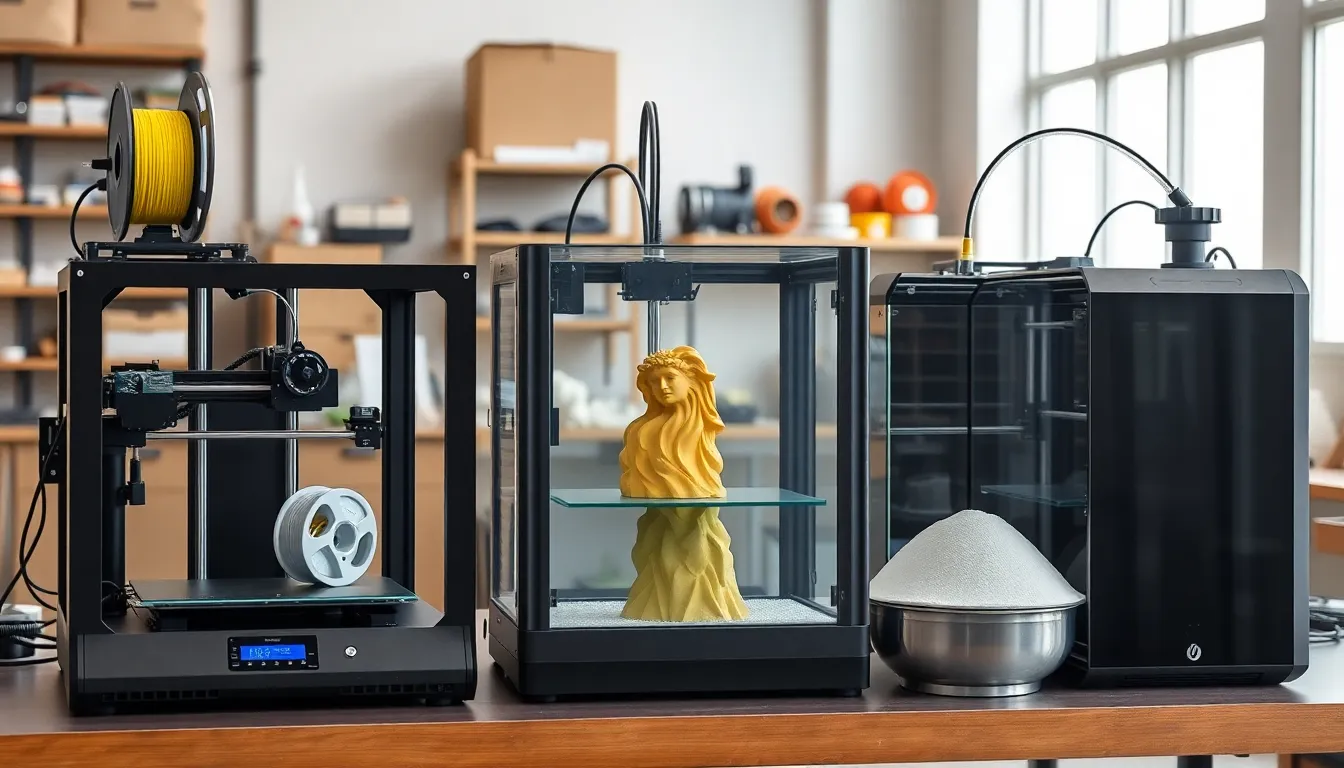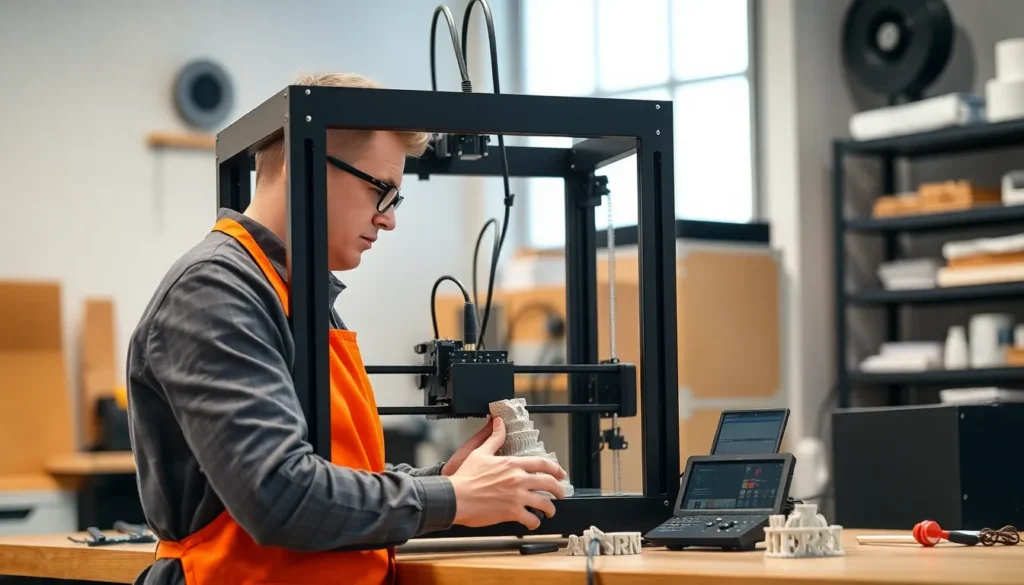In recent years, 3D printers have revolutionized the way individuals and businesses approach design and manufacturing. These innovative machines transform digital models into tangible objects, opening up a world of possibilities across various industries. From prototyping in engineering to personalized creations in art, 3D printing has become an essential tool for creativity and efficiency.
As technology advances, the capabilities of 3D printers continue to expand, making them more accessible and versatile. Whether it’s producing intricate designs or functional prototypes, these devices are reshaping traditional production methods. Understanding the different types of 3D printers and their applications is crucial for anyone looking to harness their potential.
Table of Contents
ToggleOverview of D Printers
D printers, commonly referred to as 3D printers, utilize additive manufacturing processes to create three-dimensional objects from digital files. D printers build products layer by layer, allowing for intricate designs that traditional manufacturing cannot easily achieve. Various types of D printers include:
- FDM (Fused Deposition Modeling)
FDM printers extrude melted thermoplastic filament, layering material to form objects. They are user-friendly and widely used for prototyping and hobby projects.
- SLA (Stereolithography)
SLA printers employ a laser to cure liquid resin into solid plastic. They produce highly detailed prints, making them suitable for jewelry design and dental applications.
- SLS (Selective Laser Sintering)
SLS printers use a laser to fuse powdered material, creating durable parts. They are often found in industrial settings for functional prototypes and end-use parts.
- DLP (Digital Light Processing)
DLP printers project light onto resin to solidify it. Their speed and precision make them popular for rapid prototyping and intricate designs.
- Binder Jetting
Binder jetting combines layers of powder with a binding agent. This method supports diverse materials, including metals and ceramics, facilitating complex geometries.
D printers find applications across various fields, transforming design, production, and innovation. Industries such as healthcare, aerospace, and automotive leverage these technologies to create custom parts, streamline processes, and reduce waste. The continuous evolution of D printer technology influences accessibility and functionality, catering to a growing user base.
Types of D Printers

Understanding the types of 3D printers is crucial for maximizing their potential in various applications. Each type utilizes distinct technologies, yielding different outcomes and benefits.
Fused Deposition Modeling (FDM)
Fused Deposition Modeling (FDM) remains the most common type of 3D printing technology. This process involves extruding thermoplastic filament through a heated nozzle, creating layer-by-layer solid structures. FDM printers excel in producing functional prototypes and durable parts. Materials like PLA, ABS, and PETG are often used, catering to various applications from hobbyist projects to industrial components.
Stereolithography (SLA)
Stereolithography (SLA) employs a UV laser to cure liquid resin into hardened plastic. This method allows for high-resolution prints with intricate details and smooth surfaces. SLA shines in applications requiring precision, such as dental models and jewelry design. The materials used in SLA can include photopolymer resins tailored for different mechanical properties, ensuring a versatile range of applications.
Selective Laser Sintering (SLS)
Selective Laser Sintering (SLS) utilizes a powerful laser to fuse powdered material, often nylon, into solid structures. This technology creates parts with complex geometries and excellent mechanical properties. SLS is ideal for functional prototypes and end-use parts in industries like aerospace and automotive. The ability to produce strong, durable components makes SLS a preferred choice for professionals seeking high-performance applications.
Applications of D Printers
3D printers play a crucial role in various applications, enhancing capabilities across multiple sectors. Their versatility fosters innovation in prototyping, healthcare, and education.
Prototyping and Manufacturing
Adopting 3D printers in prototyping and manufacturing revolutionizes product development. They allow for rapid creation of prototypes, enabling designers to test and iterate more frequently. Commonly used materials include thermoplastics in FDM printers, which produce functional parts quickly. This technology streamlines the manufacturing process by reducing lead times from weeks to days. Moreover, the ability to create complex geometries with minimal waste lowers production costs, making 3D printing an efficient alternative to traditional methods. Businesses in industries like electronics and automotive frequently utilize 3D printers for custom parts and specialized components.
Medical and Healthcare
3D printers significantly influence the medical and healthcare sectors by creating patient-specific solutions. They facilitate the fabrication of custom prosthetics and orthotics tailored to individual needs, enhancing comfort and functionality. Additionally, surgical models produced through 3D printing allow surgeons to rehearse complex procedures, improving surgical outcomes. Technologies like SLA enable the production of detailed anatomical models for training and education purposes. Furthermore, bioprinting is emerging as a groundbreaking application, potentially allowing for the creation of tissue and organ structures for transplantation and research.
Education and Research
In education and research, 3D printers serve as valuable tools for hands-on learning and experimentation. Schools and universities integrate these machines into curricula, helping students develop skills in design and engineering. Through projects, students learn about the entire design process, from concept to print. Researchers leverage 3D printing for prototyping experiments, allowing for quick modifications and testing of hypotheses. Collaborative efforts across disciplines benefit from the ability to produce custom materials and equipment, enhancing research capabilities in fields like materials science and robotics.
Advantages of D Printers
D printers offer several advantages that enhance functionality and practicality in various applications. Their impact is evident in areas like cost savings, customization, and speed.
Cost-Effectiveness
Cost-effectiveness stands as a key advantage of D printers. They reduce material waste significantly when compared to traditional manufacturing methods, which often involve cutting away excess materials. For example, additive manufacturing techniques allow for the precise use of only necessary materials, minimizing costs. Additionally, the ability to produce prototypes in-house eliminates the need for expensive outsourcing, further lowering overall project expenses.
Customization
Customization represents another notable benefit of D printers. They enable the creation of tailored products suited for individual needs. With D printers, users can easily modify digital designs to achieve unique shapes and functionalities. This flexibility becomes crucial in sectors like healthcare, where personalized prosthetics and medical devices can address specific patient requirements, enhancing overall care.
Speed and Efficiency
Speed and efficiency are paramount advantages of D printers. They facilitate rapid prototyping, allowing designs to transition from concept to physical model in a matter of hours. In industries like automotive or aerospace, this acceleration streamlines product development timelines, reducing time-to-market. Furthermore, D printers support efficient production runs, as they require minimal setup time compared to traditional equipment, resulting in faster turnaround for production needs.
Challenges and Limitations
3D printers face several challenges and limitations despite their numerous advantages. Understanding these issues is essential for anyone looking to adopt or innovate with this technology.
Material Limitations
Material selection restricts the capabilities of 3D printers. Different printing technologies utilize specific materials, impacting the range and properties of final products. For instance, FDM printers primarily work with thermoplastics, which may lack the strength or heat resistance required for certain applications. SLA printers use photopolymer resins, which can be brittle, limiting their use in functional parts. SLS can work with nylon and metals, but these materials can be costly and require specialized handling. Additionally, limited availability of materials can hinder creativity and design options, forcing users to compromise on functionality or aesthetics.
Print Quality Issues
Print quality presents a significant challenge in 3D printing. Factors such as layer resolution, surface finish, and accuracy directly affect the final product. Inconsistent extrusion in FDM printers can lead to visible layer lines, while SLA printers may struggle with resin curing, resulting in defects like warping or incomplete prints. SLS printers, while capable of producing complex geometries, often face issues with thermal distortion that can affect precision. Maintaining optimal printer settings and calibration is crucial, yet it demands expertise and can be time-consuming. Achieving high-quality outputs consistently remains a significant hurdle in the 3D printing process.
3D printers are revolutionizing the way individuals and businesses approach design and manufacturing. With their ability to create complex and customized objects quickly and efficiently, these machines are paving the way for innovation across various sectors. As technology continues to advance, the accessibility and versatility of 3D printing will only increase, making it an essential tool for anyone looking to enhance their creative and production capabilities.
While challenges like material selection and print quality still exist, understanding these factors can empower users to maximize the benefits of 3D printing. Embracing this technology is not just about keeping up with trends; it’s about unlocking new possibilities in design, prototyping, and production that can lead to significant advancements in numerous industries.




